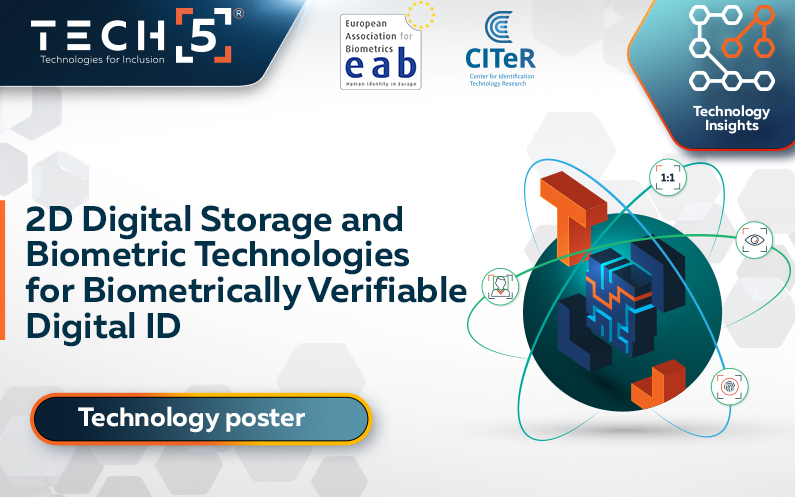Introduction
Today, the world’s population hovers at around 8Bn. Of those 8Bn people, only 17% live in developed countries. That’s just 1.3Bn people, meaning that over 6Bn still live in developing countries. In the Western world, people usually take for granted ‘normalized’ technological advancements such as cars, credit cards, computers, and smartphones. While it is correct to assume that the elites in the metro cities of developing countries also have access to these technologies, the vast majority of the world’s population still lacks behind.
With the technological boom, it is very likely that more than half of the people on this planet will have some form of Digital ID in the upcoming years. However, it is highly imperative that the solution should be designed in a way that the identities are decentralized, and that security, privacy, and inclusion are properly addressed.
The next generation digital IDs must reach the next 6Bn, and take into account all foreseeable scenarios, whether for a developed country or a developing one.
In this poster, we will share TECH5’s vision and approach to using a 2D digital storage ID technology for the issuance and biometric verification of digital ID. This approach allows to facilitate online and offline verification of a Digital ID, issued in an electronic or printed format, and bind an identity holder to their digital ID biometrically.
Next-Generation Digital ID and TECH5’s Approach
We believe that the next generation of Digital ID should have the following mentioned characteristics:
- Should include verified attributes about an individual derived from a trusted source.
- Should be biometrically linked to the individual.
- Should be available in both digital and physical forms.
- Should facilitate biometric authentication by an authorized third party.
It is also important for the credential to be in a visual format so that it can be presented either electronically or be printed. The credential should itself act as a secure digital container and thus will be “substrate agnostic”. Being digital in origin, it can also be transmitted entirely electronically.
An innovative Encrypted 2D Digital Storage ID
– T5-Cryptograph
T5-Cryptograph is a proprietary machine-readable code, encrypted and protected on multiple levels to ensure the security of the data stored in it.
This technology can very reliably and conveniently transform any existing document, without electronics, into one carrying a secure digital ID which can be biometrically verified in an online or offline manner.
Digital ID container – what is inside
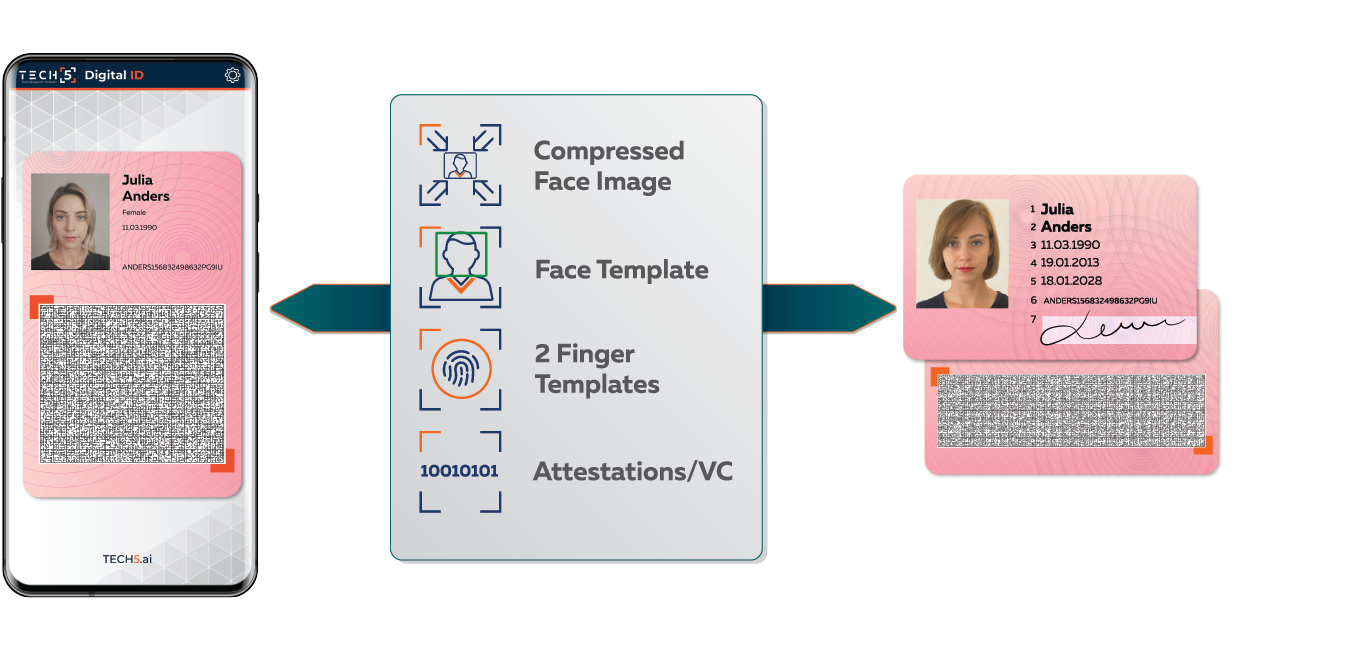
QR-Code vs T5-Cryptograph
The TECH5’s 2D digital data container may look like a QR code, but it is much more advanced and secure in every way.
T5-Cryptograph stores up to 9 times more data, has multiple level of data protection, allows for data redundancy, and stores biometric and biographical data of its holder, allowing for completely offline verification. T5-Cryptograph can be issued via internet or simply printed on a piece of paper, and will work in the same manner, allowing for verification within seconds using only a verifier’s mobile phone’s camera.
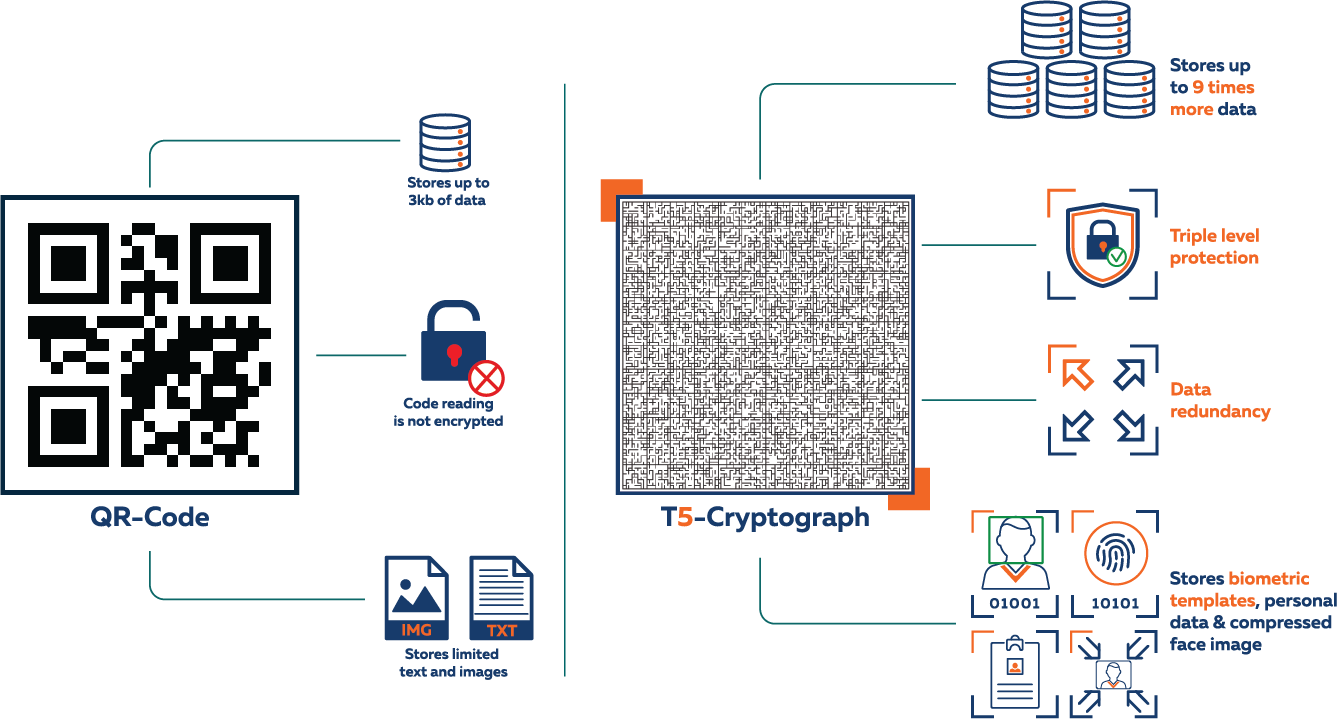
Architecture of a Digital ID with T5-Cryptograph as a 2D Digital Container
This figure depicts the architecture of a Digital ID incorporating the T5-Cryptograph as a 2D Digital Container. New key terms are defined below:
- T5-IDencode – a technology platform for digital ID issuance.
- T5-OmniMatch ABIS – a mission critical multi-biometric identification and verification platform allowing for identification, de-duplication and verification by face, fingerprints, and iris.
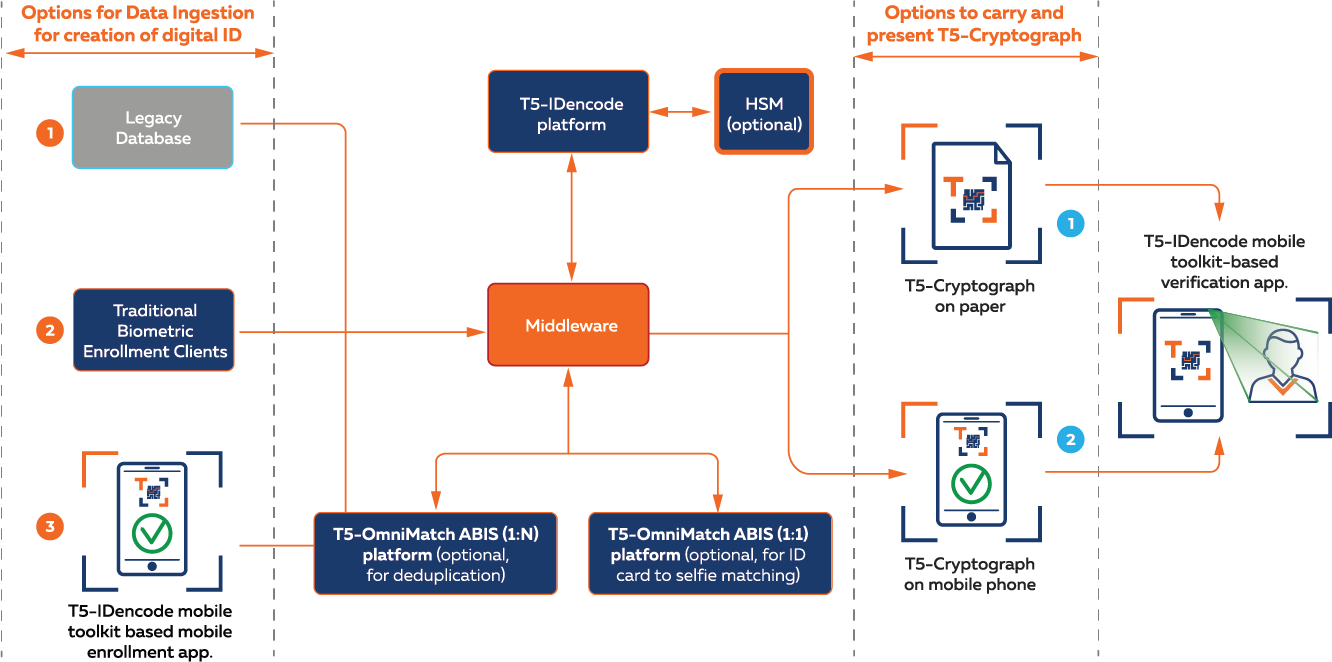
AI-Based Biometric Technologies for Contactless Capture and Verification of Digital ID
Contactless Biometric Capture
Contactless biometrics capture technologies can be used for Digital ID issuance and verification. This allows for fast, accurate, and frictionless capture using a camera of a mobile device. Data are captured in a standard format compatible with legacy recognition systems.
The “contactless” benefit of biometric capture is more relevant in the post-pandemic era where individuals want to refrain from touching surfaces.
The captured biometric data can be used for:
- Digital onboarding;
- Verification;
- Offline authentication on a mobile device.
Contactless Fingerprint Capture
Definition: Capturing fingerprint images using cameras on standard phones for matching with legacy fingerprint scanner images or other contactless fingerprint images.
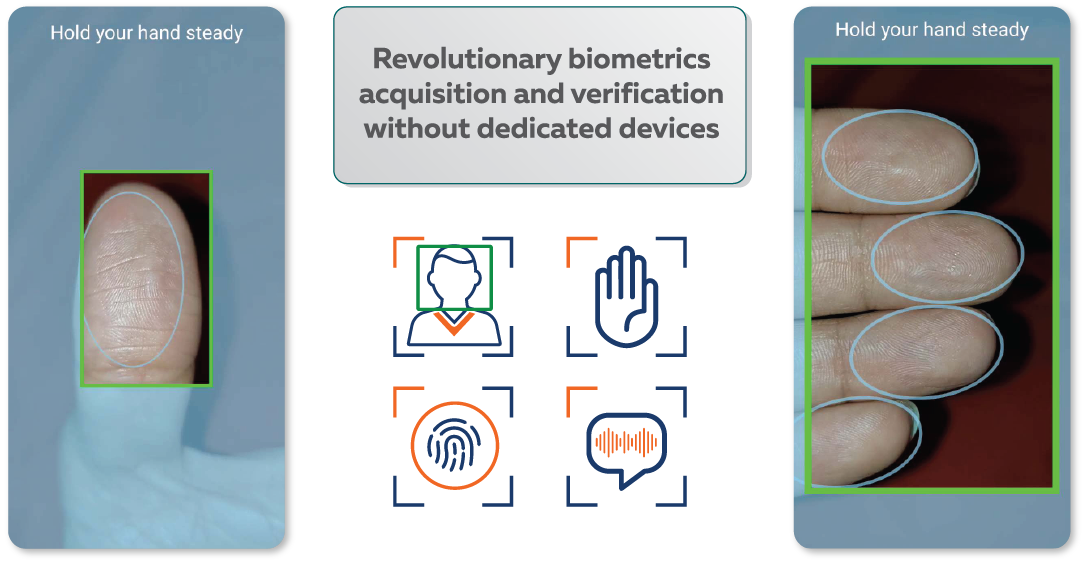
Motivation / the key driving factors:
- Ease of deployment – just download the software;
- Wide range of device options, and easy support (phones);
- Phone penetration (especially in 1:1), almost every qualified user has a phone.
In response to the increased demand for contactless biometric solutions during the pandemic, TECH5 has made its T5-Finger offering contactless, incorporating a neural networks-based fingerprint capture algorithm. This innovation, called T5-AirSnap Finger, facilitates the detection and capture of fingerprints in real-time using the integrated camera subsystem of a standard mobile phone rather than purpose-built devices traditionally used for fingerprint capture. Fingerprints are captured and processed in a standard format compatible with legacy fingerprint recognition systems.
Features

Technological Achievements
- Efficient filtering to ensure high quality friction ridge representation;
- Image processing to ensure image quality like contact-based scanners;
- DPI estimation to scale images close to 500 dpi using standard phones;
- Higher accuracy using depth sensors if available;
- Technology to flatten images of the 3D fingers.
Default vs Optimized Noise Filter
Mobile phone manufacturers tend to implement filtering techniques on images to make them visually good for humans. This hurts fingerprint capture performance.
TECH5 turns off these filters and uses a custom-made proprietary filtering technique that is driven by domain knowledge to produce high fidelity ridge information reducing false minutiae.
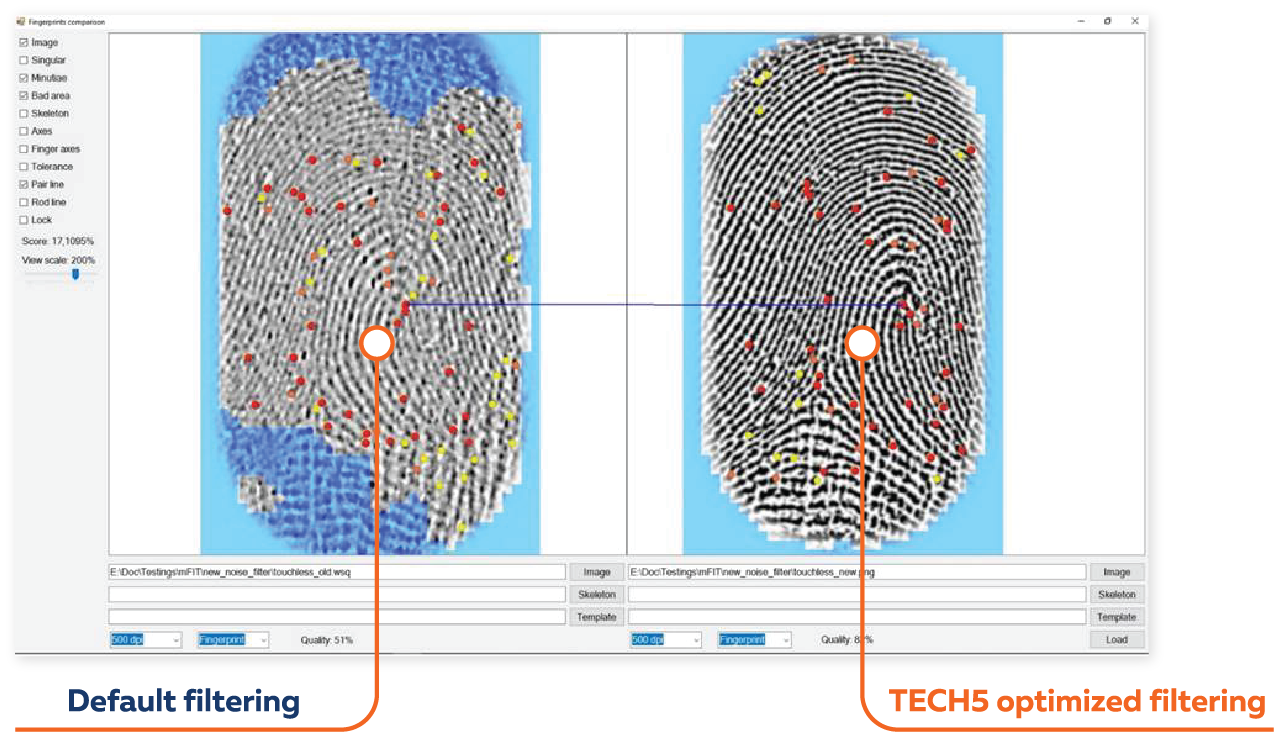
Flattened Contactless vs Contact
The other problem that TECH5 solves is to flatten the 3D surfaces. Fingers are 3D objects and hence the ridge density changes as the finger surface curves off at the edges.
TECH5 technology leverages its domain knowledge in fingerprints and implements a technique that normalizes the ridge density as close as possible to a contact print even at the edges.
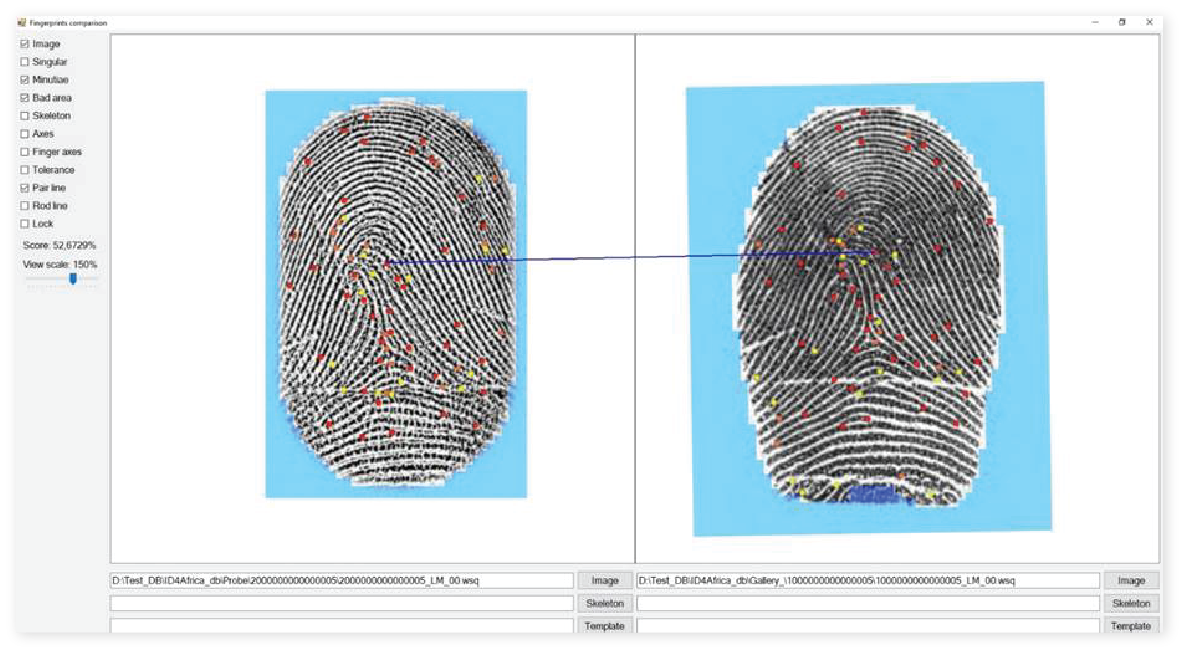
Benchmarks
- A fingerprint identification experiment was undertaken in which the enrolled gallery consisted of 3 million identities with legacy fingerprints and 210 identities with contactless fingerprints.
- The FNIR@FPIR of 0.1% was 0.89%.
- It was also observed that increasing the background population did not significantly degrade the accuracy.
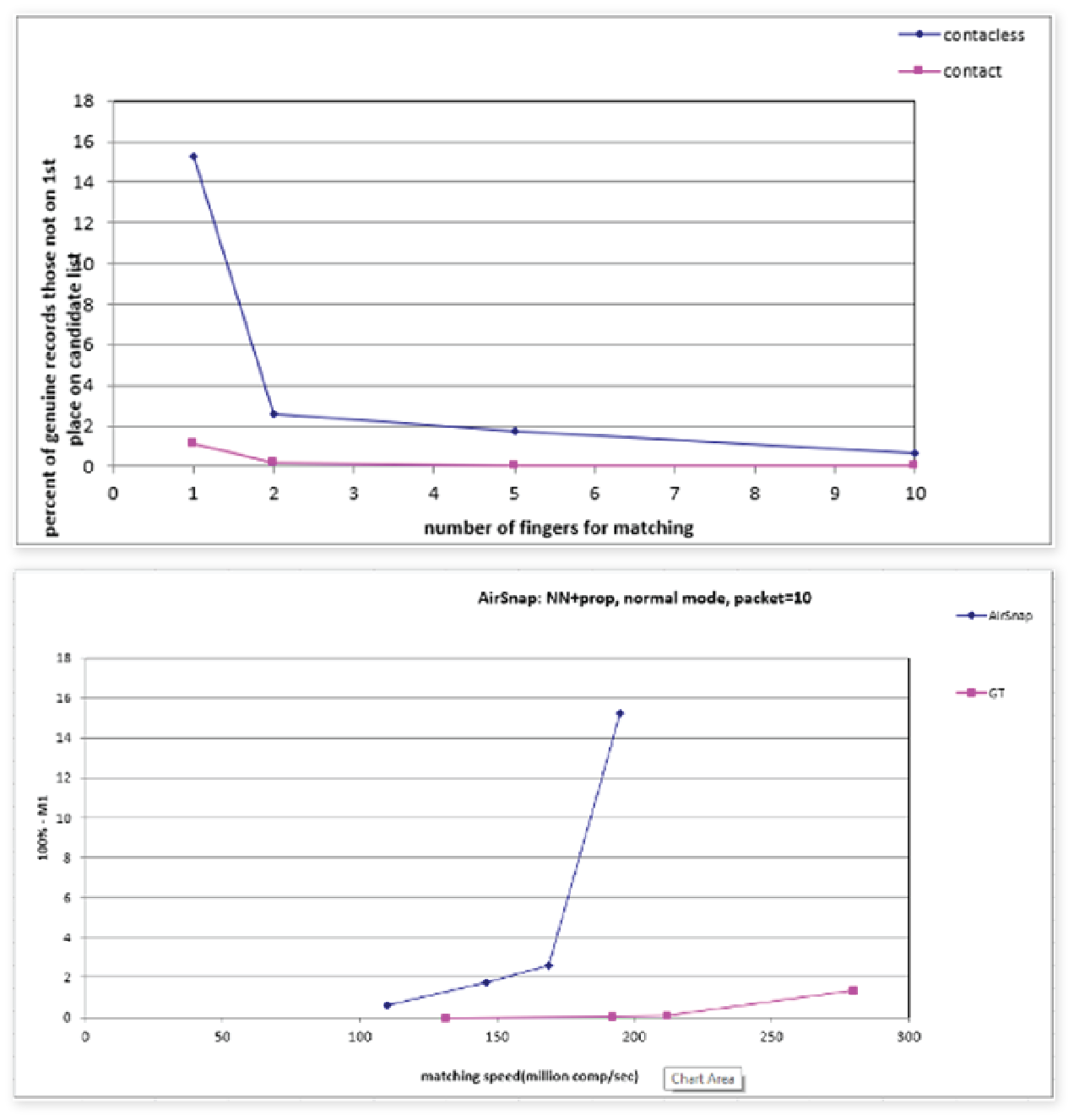
The Captured Fingerprints be Used for Digital ID Verification (1:1 Matching)
- Matching contactless to contact or contactless to contactless is widely deployed and in use in many countries.
- This is a relatively less complex problem as it is a 1:1 comparison, and matchers can be easily configured for higher tolerance. The possibility for users to retry also increases efficacy.
Learn more about TECH5’s contactless capture offering
Biometrics Matching
Biometric matching refers to comparing two biometric samples in order to decide if they belong to the same identity or not. Algorithms facilitate this by extracting features (or information) from captured biometric samples.
While traditional approaches focused on extracting human-crafted features, we at TECH5 use Artificial Intelligence for several reasons:
- Neural Networks (NN) are Universal Function Approximators;
- Large Dataset + Deep Model = Rich Features.
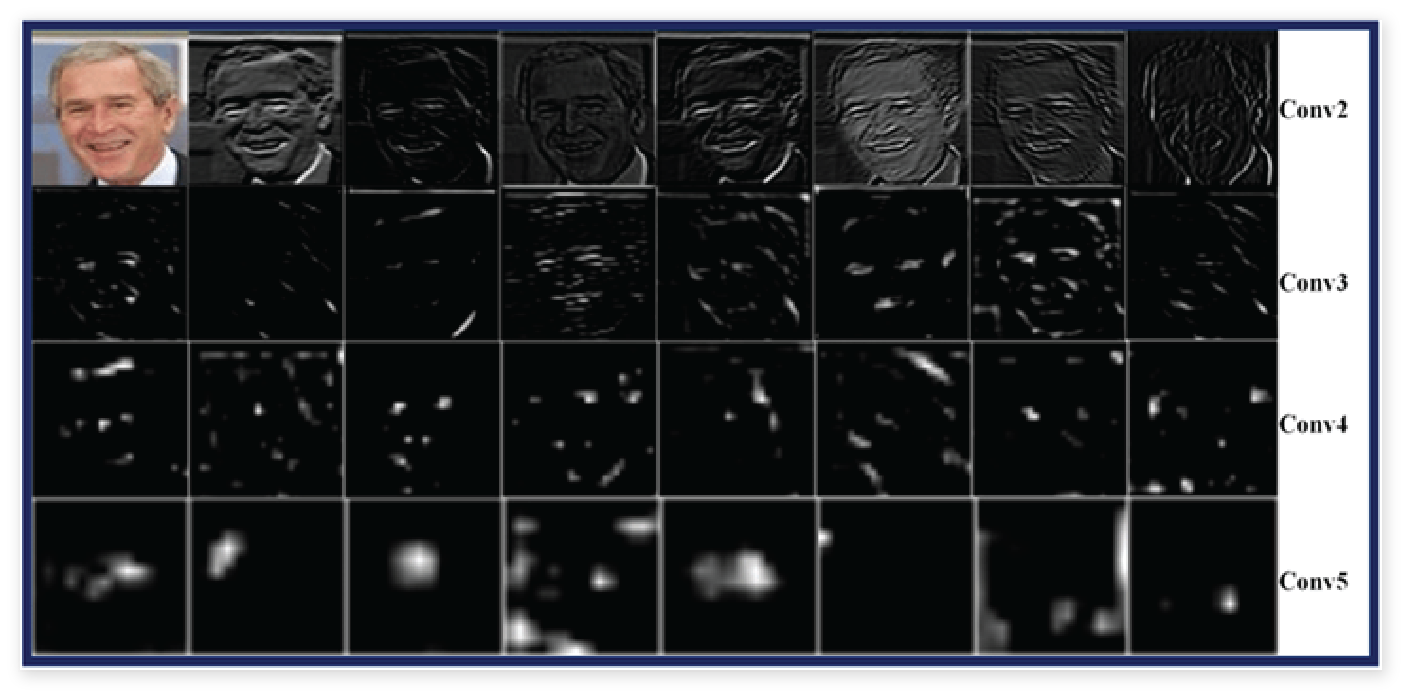
AI approach for biometrics matching tackles all cons of traditional biometrics:
- Extremely fast feature extraction and matching, utilizing the computing powers of GPUs;
- Small and fixed template size: TECH5’s Digital-ID uses 136-bytes face and 184-bytes fingerprint templates.
- Rich features:
- Information-rich features result in higher matching accuracies;
- Tolerance:
- Unlike traditional algorithms, NN-based biometric templates are scale and rotation-invariant.
Combining Traditional and AI-based Algorithms
Biggest requirement of AI-based methods is DATA for training that is:
- Not readily available;
- Constrained privacy laws and IRB approvals;
- NN-based deep features + Handcrafted features:
- NN networks guided by domain knowledge;
- Huge boost in both Accuracy and Speed:
- TECH5’s Traditional + NN Fingerprint and Iris algorithms are the fastest and one of the most accurate in the world, according to NIST evaluations.
TECH5’s Traditional + NN Fingerprint Matcher in NIST PFT III
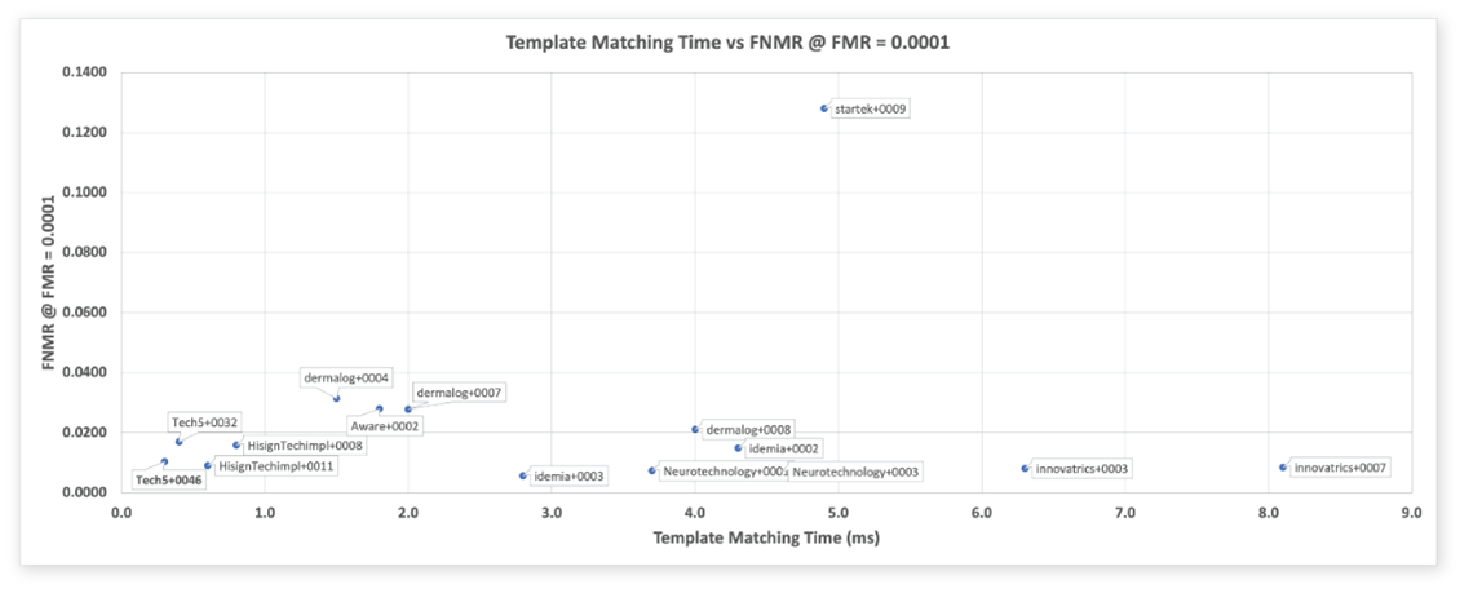
Learn more about TECH5’s biometric matching offering
Conclusion
Apart from the fact that every individual should be entitled to a Digital ID, it is crucial to recognize that the current generation of Digital IDs needs a major overhaul. A Digital ID should be highly secure, decentralized, and inclusive towards billions of people. To facilitate this, the ID should allow for fast, easy, and cost-efficient issuance along with biometric verification, even in an environment with no internet and no access to central databases.
This is being shown to be achieved by next-gen Digital IDs, such as the T5-Digital ID, which uses contactless biometric capture technologies coupled with secure data containers. With the technology ready to be deployed in many countries, we are confident that such a technology will be a game-changer and be used in a variety of use cases, from verifiable concert tickets to identity documents.

